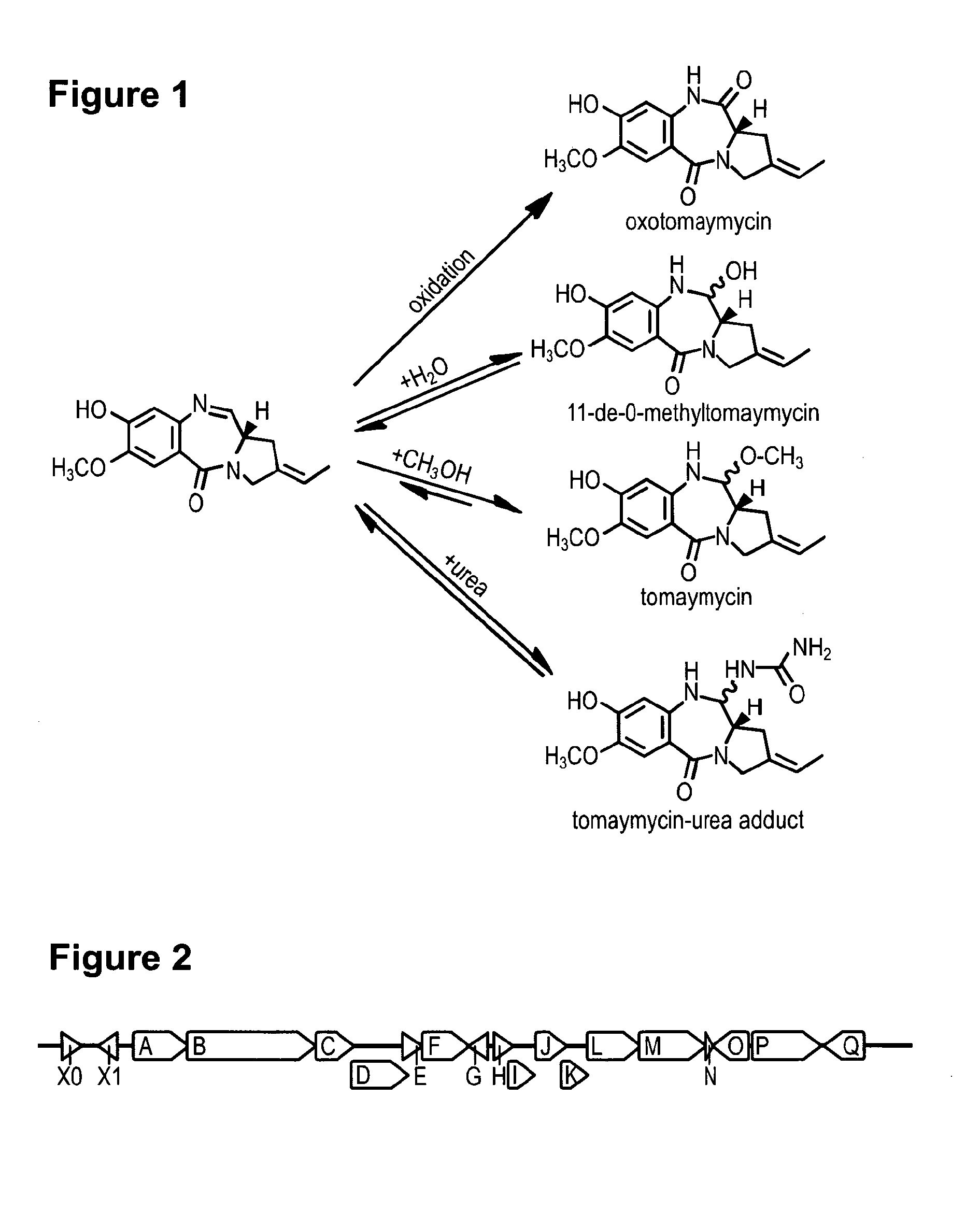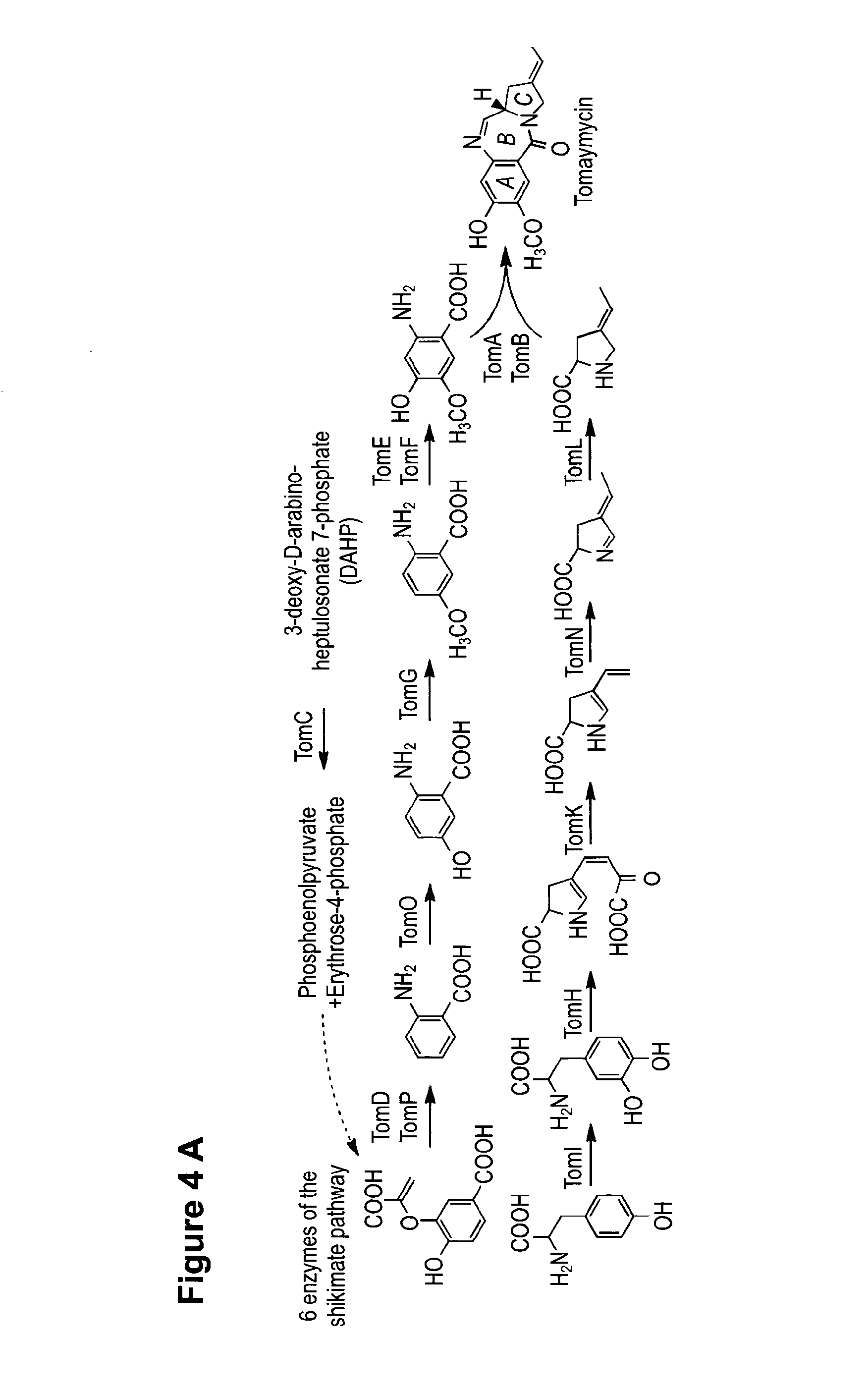Method for Producing Recombinant 11-De-O-Methyltomaymycin
- Summary
- Abstract
- Description
- Claims
- Application Information
AI Technical Summary
Benefits of technology
Problems solved by technology
Method used
Image
Examples
example 1
Knock Out of Biosynthetic Genes from the Tomaymycin Biosynthetic Gene Cluster
[0071]To enable mutasynthesis of tomaymycin analogous structures genes providing the precursors of the biosynthesis were deleted in the heterologous expression system. The anthranilic acid derivative incorporated in tomaymycin is derived from 3-deoxy-D-arabino-heptulosonate-7-phosphate partially utilizing the intrinsic shikimate pathway of the native producer strain or the heterologous host. For exchange of the A-Ring the genes tomC, tomD, tomE, tomF and tomG, were deleted. S. albus J1074 strains carrying the resulting plasmid pStW102tcΔC-G are not producing tomaymycin but did incorporate 2-amino-5-bromobenzoic acid. Deletion of tomH and tomI also eliminated tomaymycin production but allowed incorporation of (S)-4-methylenepyrrolidine-2-carboxylic acid.
[0072]Deletion of genes from pStW102tc involved in the supply of precursors for tomaymycin was performed by Red / ET as described by the supplier (GeneBridges)...
example 2
Phenotypical Verification of S. albus J1074 / pStW102tcΔtomC-G and S. albus J1074 / pStW102tcΔtomHI
[0074]Mutasynthesis was performed by cultivation of the mutagenized strains in 500 μl production medium (20 g / l soy flour, 10 g / l corn steep solid, 20 g / l glycerol, 7.5 g / l NaCl, 2 g / l CaCO3) in a punctured 2 ml reaction tube at 30° C. and 1000 rpm. After 24 h S. albus J1074 / pStW102tcΔtomC-G cultures were complemented with 2-amino-5-bromobenzoic acid. S. albus J1074 / pStW102tcΔtomHI cultures were supplemented with (S)-4-methylenepyrrolidine-2-carboxylic acid (chemicals provided by Sanofi-Aventis) to a final concentration of 500 μM each. After 24 h samples were taken and analyzed by HPLC-MS.
example 3
Production of 9-chloro-11-de-O-methyl-8-deshydroxy-7-hydroxytomaymycin (CDHT)
[0075]200 ml of production medium (20 g / l soy flour, 10 g / l corn steep solid, 20 g / l glycerol, 7.5 g / l NaCl, 2 g / l CaCO3) complemented with 60 μg Apramycin / l in 2.5 l buffled flasks with tissue caps were inoculated with 10 ml from a densely grown overnight culture of S. albus J1074 / pStW102tcΔC-G. The culture was incubated at 30° C. and 150 rpm overnight followed by feeding with 17.2 mg 2-amino-3-chlorobenzoic acid dissolved in 200 μl DMSO giving a final concentration of 0.5 mM. Incubation was repeated overnight under said conditions. Cells were pelleted by centrifugation and discarded. pH of the supernatant was adjusted to 7.0 and it was washed two times with 1 volume of hexane. Extraction was performed twice with 1 volume of ethyl acetate, organic layers were pooled and dried by rotary evaporation. Crude extract was solved in 1.5 ml H2O / acetonitrile (1:1 v / v) and subjected to semipreprative HPLC for isolat...
PUM
| Property | Measurement | Unit |
|---|---|---|
| Fraction | aaaaa | aaaaa |
| Fraction | aaaaa | aaaaa |
| Fraction | aaaaa | aaaaa |
Abstract
Description
Claims
Application Information
 Login to View More
Login to View More - R&D
- Intellectual Property
- Life Sciences
- Materials
- Tech Scout
- Unparalleled Data Quality
- Higher Quality Content
- 60% Fewer Hallucinations
Browse by: Latest US Patents, China's latest patents, Technical Efficacy Thesaurus, Application Domain, Technology Topic, Popular Technical Reports.
© 2025 PatSnap. All rights reserved.Legal|Privacy policy|Modern Slavery Act Transparency Statement|Sitemap|About US| Contact US: help@patsnap.com



